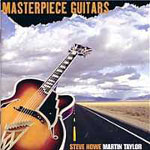Home » Jazz Articles » Album Review » Steve Howe/Martin Taylor: Masterpiece Guitars
Steve Howe/Martin Taylor: Masterpiece Guitars
The untrained ear would not be expected to appreciate many of the subtleties and sonic nuances that differentiate the multitude of guitars that are used on this recording. Fortunately Howe, Taylor and Chinery have not only listed each and every guitar used on every track, they've identified the function of each guitar, and included pictures of the instruments to boot. And so it becomes possible to appreciate the distinctive personalities of all the instruments used and understand some of the reasons why specific instruments were chosen for particular musical roles. On "Blue Bossa," for example, Taylor plays a simple rhythm track and then layers solos by no less than eighteen guitars—with their positions listed second-by-second in the liner notes—laying waste to the naïve concept that a guitar is just a guitar.
The material ranges from pretty duets like "Two Teardrops," where Howe and Taylor utilize D'Aquisto Teardrop model guitars, to solo pieces including the folksy "Ginger," where Taylor uses a Larson "Big Boy" Stereo guitar to create a sound larger than life for one instrument. Other tracks involve the two players either alone or together layering multiple guitar tracks to build a semblance of a guitar orchestra. On "Tailpiece" Howe uses no less than seven tracks to build a miniature guitar suite that ranges from gorgeous ambience to an almost bluegrass feel using a Gibson Banjo Guitar.
That Taylor and Howe are exceptional guitarists is without question. Howe, in particular, though, never ceases to amaze. Within the context of Yes he can sometimes feel sloppy and a bit forced, but here, as he pays tribute to the instrument that has given him a lifelong career and purpose, he is completely relaxed and his playing is smooth and seemingly effortless.
The entire record would, on its own, be a beautiful example of the diversity of the guitar, stylistically, texturally and sonically. But when combined with the ambitious nature of documenting the literally dozens of guitars used, Masterpiece Guitars becomes an engaging lesson in infinite possibilities, one that can be carried over to the instrument of your choice.
Visit Steve Howe and Martin Taylor on the web.
Track Listing
Two Teardrops; No Pedestrians; Smile; La Questa; All the Things You Are; Thought Waves; Thank Heaven for Little Girls; Ginger; Blue Bossa; Tailpiece; Cherokee Ridge; The Sunshine of Your Smile; Goofus; Moon River; Ae Fond Kiss/Farewell to Erin; Somewhere; Harpnosis
Personnel
Steve Howe: guitar; Martin Taylor: guitar.
Album information
Title: Masterpiece Guitars | Year Released: 2004 | Record Label: P3 Music
< Previous
Too Damn Hot!
Next >
Musical Culture
Comments
Tags
For the Love of Jazz
 All About Jazz has been a pillar of jazz since 1995, championing it as an art form and, more importantly, supporting the musicians who create it. Our enduring commitment has made "AAJ" one of the most culturally important websites of its kind, read by hundreds of thousands of fans, musicians and industry figures every month.
All About Jazz has been a pillar of jazz since 1995, championing it as an art form and, more importantly, supporting the musicians who create it. Our enduring commitment has made "AAJ" one of the most culturally important websites of its kind, read by hundreds of thousands of fans, musicians and industry figures every month.



















